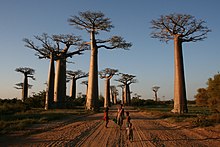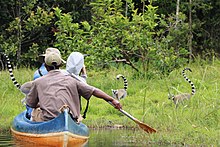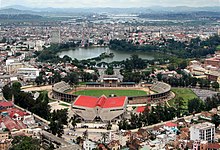Tourism in Madagascar

Despite a high potential for tourism, tourism in Madagascar is underdeveloped. Madagascar's tourist attractions include its beaches and biodiversity. The island's endemic wildlife and forests are unique tourist attractions.[1] However, historical sites, craftsmen communities, and relaxed cities make it a favorite with return travellers.
Tourist attractions[]

Madagascar has been isolated from the African landmass for approximately 165 million years and its flora and fauna evolved in isolation from that time onwards.[2] The island is one of the world's most biologically diverse areas, and is internationally renowned as a wildlife tourism and ecotourism destination, focusing on lemurs, birds, and orchids.[3] More than half of the island's breeding birds are endemic.[2] Other native species include the red-bellied lemur, the aye-aye, and the indri (the largest lemur species).[4]
One of the best places to observe the indri is the Analamazoatra Reserve (also known as Périnet), four hours away from the capital.[3] The presence of the indri has helped to make the Analamazoatra Reserve one of Madagascar's most popular tourist attractions.[5]
Historical sites can be found throughout the country, but mostly in the capital, such as the Royal Palace or Rova in Antananarivo or the sacred hill of Ambohimanga nearby, both Unesco world heritage listed sites. A popular route from Antananrivo to Tulear in the south passes through several towns noted for their handicraft: Ambatolampy (aluminium foundry), Antsirabé (gemstones, embroidery, toys), Ambositra (marquetry), and Fianarantsoa.
Tourist numbers[]

312,000 tourists visited Madagascar in 2006. Since 1990, the number of tourists in the country has grown at an average rate of 11% each year. 60% of its tourists are French,[6] who form the majority because of cultural and historical links between the countries, and flight routes.[7] People who are interested in the country's botany, lemurs,[7] birds,[8] or natural history also make up a large part of its visitors. These visitors often travel as part of a tour and stay in the country for a long period of time.
In the mid-1990s, tourism was the country's second largest export earner, bringing in US$50 million annually.[3] For 2007, tourism's contribution to Madagascar's GDP (direct and indirect impact) was estimated to account for 6.3% of GDP and 206,000 jobs (5.1% total employment).[6]
The tourist industry was badly damaged in late 2001 because of a political crisis and following economic recession. The number of tourists in 2002 fell, but the tourism industry subsequently recovered and continued to grow steadily.[7] The highest number of incoming arrivals in Madagascar was recorded in 2008, with 375,000 arrivals. But in 2009 again, a lengthy political crisis affected tourists' arrivals. Only 255,922 tourists set foot in Madagascar in 2012—still an increase of 14% compared to the 2011 numbers. The 2013 figures were again disappointing with 198,816 arrivals—this was an election year, with security issues, notably in Nosy-Be. However, the sector has been growing steadily for a few years; In 2016, 293,000 tourists landed in the African island with an increase of 20% compared to 2015; For 2017 the country has the goal of reaching 366,000 visitors, while for 2018 government estimates are expected to reach 500,000 annual tourists.[9]
Development of tourism[]
There is growing interest in the country as a tourist destination.[7] The country has beautiful landscapes and the cultural resources to support tourism. These resources provide many opportunities for the development of both ecotourism and resort based tourism.[6] Despite its growth, the tourism industry is very small. It is much smaller than those of the neighbouring Seychelles and Mauritius islands, and is the smallest among the islands in the Indian Ocean.[7]
Madagascar's government has promoted tourism as an economic development strategy.[3] With over 70% of the country living in poverty, tourism is seen as a way to reduce poverty and provide economic growth. Tourism is currently the second-largest foreign exchange earner in the country, and the government hopes to increase this share. Still in the early stages of development, there is large potential for the tourist industry to grow as Madagascar's infrastructure improves.
The tourism industry has a number of large challenges. Travel and tourism is poorly diversified, the infrastructure is poor, roads are poorly paved, and airline travel is expensive and unreliable. There are few high quality hotels, and fewer that meet international standards;[7] Madagascar has approximately 550 hotels, about 110 of which have been classified as meeting international standards.[6]
Air Madagascar and Air France dominate air travel, which makes the price of flights expensive. The country's status as a long-haul destination further increases prices.[7]
One of the main actors who help the development of tourism in Madagascar is the Ministry of Tourism of Madagascar and also the National Tourism Office of Madagascar. In addition to these two major players in tourism, regional offices have also been placed in the ranks of cities in the country to contribute to the development of tourism in each of their localities. Aside from that, there are numerous travel agencies that organize tours throughout the big island, the most well-known of which is Natura Travel.
| Organization | Contact | Adress |
|---|---|---|
| Tamatave Regional Tourist Office (ORTT) | +261 (0) 34 47 301 68 | ORT: Maison de l'information, 83 boulevard Joffre - 501 Tamatave |
| Nosy Be Regional Tourist Office (ORTNB) | +261 (0) 32 05 546 52 | Cours de Hell Ville, Face de la préfecture de Police de Nosy-Be |
| Regional Tourist Office of Analamanga (ORTANA) | +261 (0) 34 20 270 51 | Immeuble Ifanomezantsoa, Escalier Ranavalona – Antaninarenina 101 – Antananarivo, Madagascar |
| Vakinankaratra Regional Tourist Office (ORTVA) | +261 (0) 34 18 885 16 | C/O MTTM Sud De La Gare Antsirabe 110 Madagascar |
| Regional Tourist Office of SAVA (ORTSAVA) | +261 (0) 34 63 647 30 / +261 (0) 32 67 487 76 | Immeuble Ny Havana - 208 Sambava |
| Diego Suarez Regional Tourist Office (ORTDS) | +261 (0) 32 04 332 20 | Angle 03 Rue Colbert/ Angle Rue Flacourt - 201 Diego Hotel De Ville ORTDS |
| Regional Tourist Office of Fianarantsoa (ORTF) | +261 (0) 34 07 570 85 | LOT IN29 Ambatolahikosoa, en face du Tranovato. |
| Sainte Marie Tourist Office (OTSM) | +261 (0) 32 11 442 00 | Le Barachois – Amboditfotatra |
| Tulear Regional Tourist Office (ORTU) | +261 (0) 34 07 807 67 | Ankilisoafilira Bazar Be- 601 Toliara |
| Office Régional du Tourisme de l'Anôsy (ORTAnôsy) | +261 (0) 34 60 614 80 | 3 RUE Abel Realy Bazaribe Ford Dauphin 614 - BP 29 |
| Majunga Regional Tourist Office (ORTMAJ) | +261 (0) 32 40 029 89 / +261 (0) 33 73 777 07 | 14 avenue Philibert Tsiranana, Manga, Mahajanga 401 |
| Menabe Regional Tourist Office (ORTMEN) | +261 (0) 34 41 163 72 | Kiosque au Bord de la mer - Route de Nosikely - Morondava |
| Amoron'i Mania Regional Tourist Office (ORTAM) | +261 (0) 34 50 955 16 / +261 (0) 34 52 155 16 | Lot 01 C 20 Alakamisy Ambositra (ETS TSITO TOURS) |
| Sofia Regional Tourist Office (ORTSOFIA) | +261 (0) 33 08 881 18 / +261 (0) 34 46 232 41 | AMBALABE OUEST 1/ Pres du Parckage |
| Itasy Regional Tourist Office (ORTITA) | +261 (0) 32 40 599 15 | Hotel des Volcans Miarinarivo |
| Regional Tourist Office Isalo Ihorombe (ORTII) | +261 (0) 33 12 195 73 / +261 (0) 34 13 150 02 | ORT Isalo Ihorombe - Ranohira - Ihosy 313 |
| Regional Tourist Office Alaotra Mangoro (ORTALMA) | +261 (0) 34 41 201 21 / +261 (0) 34 64 939 60 | Immeuble Restaurant Bezanozano, 1er étage Moramanga BP 88 |
| Betsiboka Regional Tourist Office (ORTBE) | +261 (0) 33 78 627 42 / +261 (0) 32 07 744 09 / +261 (0) 34 49 642 77 | Hötel Restaurant KATSEM Andranomangatsika 412 – Maevatanana |
| Regional Tourist Office Vatovavy Fitovinany (ORTV7V) | +261 (0) 34 95 141 81 | Bureau de la DRTTM V7V en face de la Gare FCE |
| Analanjirofo Regional Tourist Office (ORTANALA) | +261 (0) 34 10 986 12 / +261 (0) 32 02 039 10 | Bâtiment du Ministère des transports, du Tourisme et de la Météorologie, Ambatomasina, Maroantsetra. |
| Regional Tourist Office Atsimo Atsinanana (ORTAA) | +261 (0) 34 28 852 82 | Le Bungalow du Sud - Farafangana |
Visitor statistics[]
Most non-resident visitors arriving to Madagascar were from the following countries of nationality:[11]
| Country | 2017 |
|---|---|
| 60,144 | |
| 3,732 | |
| 3,083 | |
| 2,757 | |
| 2,700 | |
| 2,691 | |
| 2,621 | |
| 2,576 | |
| 2,570 | |
| 1,786 |
References[]
- ^ David Newsome, Susan A. Moore, Ross K. Dowling, 2001, Natural Area Tourism: Ecology, Impacts and Management, Channel View Publications, p.63
- ^ Jump up to: a b Sinclair, Ian; Olivier Langrand (2004). Birds of the Indian Ocean islands. Struik. p. 22. ISBN 1-86872-956-7.
- ^ Jump up to: a b c d Buckley, Ralf, Case Studies in Ecotourism, p.44
- ^ Miller, Ronald Iving, 1994, Mapping the Diversity of Nature, p.41
- ^ Mantadia National Park and Analamazaotra Special Reserve, Birdlife International
- ^ Jump up to: a b c d Tourism in OECD Countries 2008: Trends and Policies, p.64.
- ^ Jump up to: a b c d e f g Travel And Tourism in Madagascar, Euromonitor International
- ^ On Madagascar, Hollywood, Like Evolution Itself, Barely Registers, New York Times.
- ^ http://www.guidaviaggi.it/notizie/183551/madagascar-obiettivo- 500 thousand visitors-in-the-2018
- ^ "MADAGASCAR REGIONAL TOURIST OFFICES".
- ^ "Tourism Statistics 2018" (PDF) (in French). Madagascar: Minister of Tourism. Retrieved 25 November 2018.
External links[]
| Wikivoyage has a travel guide for Madagascar. |
- Tourism in Madagascar
- Tourism in Africa by country
